Wednesday, November 29, 2006
posted by pablopabla at 4:06 pm
 Stir-Fried Pork Tenderloin with Enoki Mushroom
Stir-Fried Pork Tenderloin with Enoki Mushroom
I like to eat enoki mushrooms. They are also known as "kim cham" mushrooms (meaning golden needles in hokkien) as they are longish with a small cap. These mushrooms are sometimes added to soups like Bak Kut Teh and commonly used in Japanese cooking. The stems have a crunchy bite despite it being rather thin and needle-like in appearance. It has a mild and delightful flavour and compliments well with meat dishes.
 Enoki Mushroom
Enoki Mushroom
I usually cook enoki mushrooms with meat, pork tenderloins to be exact. You can substitute the meat with chicken breasts. The enoki mushrooms are added in towards the end of the cooking time as too much cooking will render the stems tough and stringy.
This is my recipe for
Stir-Fried Pork Tenderloin with Enoki MushroomsIngredients- 200 grammes of pork tenderloins (sliced thinly)
- 1 packet of enoki mushrooms (cut off and discard the bottom of the cluster of mushrooms and gently rinse them to remove any dirt)
- 1/2 piece of carrot (julienned) - for added colour to the dish
- 3 cloves garlic (chopped)
- 2 tablespoons of cooking oil (preferably palm oil)
- 50 ml of warm water
- Corn starch (prepared using 1 tablespoon of corn flour mixed with 5 tablespoons of water)
Marinade- 1 tablespoon of light soya sauce
- a couple of dashes of white pepper powder
- 1 teaspoon of corn flour
Seasoning- 3/4 tablespoons of oyster sauce
- 1 tablespoon of chinese cooking wine
- Salt
MethodMarinade pork tenderloin for about 30 minutes.
Heat oil in wok on high heat and stir-fry the garlic till beginning to brown. Add pork tenderloin and carrots and stir-fry till meat is almost cooked. Add oyster sauce and salt to taste followed by water and bring gravy to boil. Then add the enoki mushrooms and chinese cooking wine and stir well for 30 seconds.
If it is too dry to your liking, add a little bit more warm water. If the gravy is too runny, add a tablespoon of corn starch at a time.
Serve hot with steaming white rice.
Technorati Tags :
Recipe ,
Pork ,
Mushroom ,
Chinese FoodLabels: Chinese, Dinner, Lunch, Pork


posted by pablopabla at 10:21 am
Have you heard of
Wallhogs? They provide digital printing services with a difference. They specialise in big sized prints and I am talking about 2 feet going up to 7 feet tall by 2 feet wide! That's taller than me and most people anyway. The prints will be printed on a choice of removable matt wall graphic vinyl, premium glossy photobased paper or even semi-gloss fine art paper.
Payment can be made via Visa, MasterCard, Discover, American Express and even through PayPal accounts and the prints are shipped via UPS. Safe and secure delivery right to your doorstep!
Wallhogs can even help you to remove any background junk from the picture of your choice and you can even add captions into your picture which you can then hang it on your wall. Imagine having a picture poster of your favourite food with the words "Eat me, quick!". Hmm...I might very well try that. Oh yes, the posters come with 6-colour scratch, water and fade resistant UV inks to ensure that your posters are maintenance-free. If you drool on the picture of the food, you just need to wipe it off!
Wallhogs prices start from a low USD$19.99 with the posters ready for the wall. And when I said it is ready for the wall, I mean no use of nails or screws necessary. The posters come with self-adhesive backing, which is really great for those not familiar with tools.
This is a paid post.
 Technorati Tags
Technorati Tags :
PayPerPost ,
Wallhogs ,
Advertising ,
PicturesLabels: PPP


Tuesday, November 28, 2006
posted by pablopabla at 5:43 pm
 Stir-Fried Yau Mak with Garlic
Stir-Fried Yau Mak with GarlicI like vegetables. I think I am okay with all types of vegetables except the obvious bitter ones eg. bitter gourd. I know it is good for health but I usually give it a pass. Not with green leafy vegetables though.
There are many varieties of lettuce around and most of them can be eaten raw or cooked. If you intend to stir-fry the lettuce, make sure that your wok is really heated up to very high temperature (smoking) so as to minimise cooking time and to prevent too much water oozing out from the leaves. The idea is not to have the vegetables swimming in a pool of gravy. You also lose a lot of essential vitamins and minerals by prolonged cooking of the vegetables. Here, I use a type of lettuce known as "Yau Mak" which is a slightly smaller version of the romaine lettuce. I should have taken a photo of it before the leaves were separated and rinsed.
This is my recipe for
Stir-Fried Yau Mak with GarlicIngredients- 2 pieces yau mak (or to your desired amount but bear in mind that they will shrivel and reduce in size as you cook, separate leaves and rinse well. Drain in colander to remove excess water)
- at least 5 cloves of garlic (chopped)
- 4 cloves of shallots (sliced thinly)
- 3 tablespoons of palm oil
Seasoning- 1 1/2 tablespoons of oyster sauce
MethodHeat up oil in wok and fry shallots till golden brown. Remove fried shallots aside.
Add garlic into remaining oil and stir fry for about 10 seconds followed by yau mak. Give it two or three stirs and add oyster sauce. Stir till leaves are evenly coated with sauce. I like the leaves crunchy, so I do not usually stir fry them for more than 1 minute.
Sprinkle fried shallots prior to serving.
Technorati Tags :
Lettuce ,
Recipe ,
Chinese FoodLabels: Dinner, Lunch, Vegetable


posted by pablopabla at 11:27 am
 Pork Porridge with Dried Oysters
Pork Porridge with Dried OystersLet's cook porridge / congee today! I like to eat porridge especially on for lunch on weekends. It is light and suitable on hot days especially when you want to eat something non-oily. When I plan to cook porridge for lunch, I will usually drop by at the wet market in the morning to buy yau char kuey (fritters) to compliment the porridge.
Porridge can be cooked with many different types of ingredients. Actually, the types of ingredients are only limited by one's imagination. Here, I have added minced pork, pork liver and dried oysters. The dried oysters add a little sweetness to the porridge whilst the other ingredients each have its individual taste. I also like to break an egg into the bowl prior to pouring boiling hot porridge over it. It is a taste I acquired since young (runs in the family).
Give this recipe a try. If some of the ingredients are not your type, feel free to omit them or substitute them. If you need clarification, just post them in the comments below.
This is my recipe for
Pork and Dried Oyster PorridgeIngredients- Approximately 50 to 100 grammes of rice (rinsed once and pre-soaked in water for 30 minutes)
- 100 grammes of minced pork
- 50 grammes of pork liver (sliced)
- 5 to 10 pieces of dried oyster (pre-soaked in water for 30 minutes and cut into half)
- 1 to 2 pieces of yau char kuey (cut across like in the picture above)
- 4 cloves of shallots (sliced thinly)
- 3 eggs
- 3 bowls of Water
- 2 tablespoons of palm oil
- 3 teaspoons sesame oil
Marinade (for minced pork)- 3 teaspoons of light soya sauce
- a couple of dashes of white pepper powder
- 1 teaspoon of corn flour
Seasoning- 2 teaspoons light soya sauce
- Salt
- White pepper powder
GarnishingMethodMarinade minced pork for 15 minutes or more.
Place water in a cooking pot and add rice. Cover with lid and bring to boil. Unlid and reduce heat to medium low and cook till rice becomes porridge / cooked and broken
(approximately 20 minutes). Add a little hot water when it becomes too dry. You shall strive to cook it a little runny in consistency. Midway through cooking, add the oysters.
Meanwhile, place cut yau char kuey into a toaster oven to toast it till crisp. At the same time, heat oil in wok and fry the sliced shallots till golden brown. Remove fried shallots and set aside.
Once you have cooked the porridge, bring to boil again and add the minced pork
(using a teaspoon, scoop one teaspoon of minced meat at a time) and stir. After you have finished adding all the minced pork, add the pork liver and stir the porridge till pork liver is cooked
(no more blood oozing out - yes, I know it sounds gross but it's delicious, I tell you!). Add seasoning to taste.
To serve, break an egg into bowl
(you will have about 3 servings here) and pour boiling hot porridge over the egg. Drizzle one teaspoon sesame oil and add garnishing. If you still have some of the oil used to fry the shallots, drizzle a bit as well. Finally, sprinkle the toasted and crispy yau char kuey and fried shallots over the porridge.
Enjoy! I know it may sound a bit complicated but it is actually very easy to cook if you try it.
Technorati Tags :
Porridge ,
Recipe ,
Pork ,
FoodLabels: Lunch, Pork, Porridge


Monday, November 27, 2006
posted by pablopabla at 2:01 pm
I am beginning to like PayPerPost (PPP). I did not realise how easy it is to earn side income through PPP until I signed up for it recently. Thanks to
philin and
5xmom's recommendation, I am now, perhaps, on my way to accumulating enough money to own my very own domain. I wonder what domain name should I choose?
Anyway, PPP is now catching the world in storm and many bloggers have joined the bandwagon. Apart from this, the advertisers have also increased thus giving bloggers and website owners more articles to write about. When companies or institutions
advertise on blogs, their advertisements reach a growing audience which can number in the millions considering the rate of growth of blogs. I would love it if more food companies join PPP as advertisers so that food bloggers like us can give our reviews about their products.
The other advantage of PPP is that you only blog and post about something which you feel strongly about from the list of articles made available. Unlike some other advertising programmes which you have absolutely no control over, PPP allows you to choose the topic which you want to blog or allow to be posted in your website.
Nothing beats being in control and earning money at the same time.
What are you waiting for? Sign up for PPP and if you are kind enough, do list
pablopabla at gmail dot com as your referral, will ya? That will generate USD$5.00 to me! Thanks!
This is a paid post by PPPTechnorati Tags :
PayPerPost ,
Blogging ,
MonetiseLabels: PPP


posted by pablopabla at 12:16 pm
 Sauteed Chicken Supreme with Dried Chillies
Sauteed Chicken Supreme with Dried ChilliesI can't believe that this is my 50th post! And I am truly encouraged that some have left kind words of encouragement to me for the recipes here. You can't imagine how much I beam from ear to ear when I read that some of my recipes have been tried and tested to satisfaction. It's very much like how a chef will feel when the food that has been cooked is given the thumbs up or finished cleaned on the plate.
Anyway, for the 50th post, I would like to highlight a recipe which my wife shared with me (and cooked for me). She does cook...and she cooks well too. Only thing is that I have persuaded her to allow me to use the kitchen and enjoy my hobby of cooking instead.
This dish is tasty as it is hot and spicy whilst at the same time, has a hint of sourness to it (due to the vinegar / lime used). It is also very fragrant due to the quite liberal use of chinese cooking wine. It is a variant of
Kung Po Chicken, I believe but tastes slightly different. Adjust the taste according to your preference. That very day when she cooked this dish, we had some cashew nuts at home and she decided to throw some in hence what you see in the picture. It is not in the recipe but you can add it in for extra bite!
This is my wife's recipe for
Sauteed Chicken Supreme with Dried ChilliesIngredients- 500 grammes of chicken supreme (the most tender part of chicken breast which is longish in shape, slice it to cubes / thick diagonal slices)
- 20 dried chillis (pre-soaked for 30 minutes, seeded and cut into halves)
- 5 cloves garlic (chopped)
- 4 tablespoons of cooking oil (preferably palm oil)
Marinade- 1 tablespoon chinese cooking wine
- 1 tablespoon dark soya sauce
- 2 tablespoon corn flour
Seasoning- 2 tablespoon chinese cooking wine
- 3 tablespoons of sugar
- 1 teaspoon of sesame oil
- 1 tablespoon white vinegar (or squeeze approximately 10 limes or more for juice)
- 1 teaspoon of cornflour
- 1/2 tablespoon of light soya sauce
- 1 tablespoon of water
MethodPound meat slightly with blunt side of knife or tenderiser. Marinade for 30 minutes.
Heat oil in wok, fry the dried chilli for 30 seconds and then add the garlic. Continue to stir-fry till garlic begin to brown. Add chicken and fry till cooked
(if you wish to add cashew nuts, add them now). Then add seasoning, stir well until evenly distributed and gravy dries up.
Serve hot with steamed white rice.
Technorati Tags :
Chicken ,
Dried Chilli ,
Recipe ,
Chinese Food ,
StirFryLabels: Chicken, Dinner


Thursday, November 23, 2006
posted by pablopabla at 10:54 am
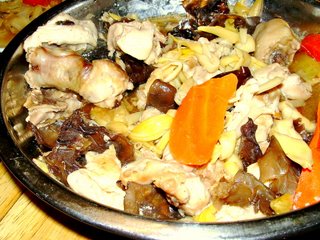 Steamed Chicken with Carrots, Wood-Ear Fungus, Dried Lilybuds and Mushrooms
Steamed Chicken with Carrots, Wood-Ear Fungus, Dried Lilybuds and MushroomsRemember I used to have a recipe called
Mixed Vegetables - Cabbage, Carrots, Wood-Ear Fungus, Dried Lily Buds and Mushrooms? Well, I am going to modify that recipe a bit instead. Using most of the same ingredients, these will be steamed together with chicken to make a nice healthy dish.
In this dish, the chicken is sweet-tasting and has a hint of chinese cooking wine as it was marinated prior to steaming. The meat will usually be tender when cooked as whole chicken leg (drumstick and thigh meat) is used and the wine further tenderises the meat. This is in contrast with the crispness of the wood-ear fungus, sweetness of the carrots and lily buds and smoky taste of the mushrooms. Truly, it comes with a riot of taste and goes well with steamed white rice.
Actually, as emphasised in most of my recipes, you don't actually have to follow the ingredients in full especially if you have difficulty finding them at the place you live. Just use a bit of creativity and substitute them with different ingredients. If you are not sure, feel free to ask me at the comment section below.
This is my recipe for
Steamed Chicken with Carrots, Wood-Ear Fungus, Dried Lilybuds and Mushrooms.
Ingredients- 2 whole chicken legs (chopped into bite pieces)
- 1 small sized carrot (sliced)
- 50 to 100 grammes of wood-ear fungus (pre-soaked till soft)
- 5 dried chinese mushrooms (pre-soaked till soft) or enoki, oyster or button mushrooms
- 50 grammes of dried lily buds (pre-soaked till soft and knotted in the middle)
- 1 whole bulb of garlic (chopped)
- 1 tablespoon of cooking oil (preferably palm oil)
Marinade for chicken- 1 tablespoon of oyster sauce
- 2 teaspoons of light soya sauce
- A couple of dashes of white pepper powder
- 1 tablespoon of chinese cooking wine
- 1 tablespoon of corn flour
Seasoning- 1 tablespoon of oyster sauce
- Salt to taste
MethodMarinade the chicken for about an hour.
Heat oil in wok, followed by garlic and chinese mushrooms. Fry till garlic begins to brown. Add carrots, wood-ear fungus and lily buds. Stir-fry for 2 minutes. Remove and set aside.
Place chicken on a suitable plate for steaming
(I use a stainless steel plate as seen in the picture above). Place the pre-stirfried vegetables on top of the chicken. Steam in wok / steamer for at least 20 minutes or until chicken is thoroughly cooked.
Technorati Tags :
Chicken ,
Vegetable ,
Recipe ,
Chinese FoodLabels: Chicken, Dinner, Vegetable


posted by pablopabla at 10:36 am
This is a quick digression from my usual recipes. As I have shared in my earlier posting, I have signed up with
PayPerPost to see if I will get paid for sharing here in my blog. True enough, my very first post through
PayPerPost has been approved and I will be paid USD$10.00 just for that one post.
It is truly that simple. All you need to do is to sign up an account at
PayPerPost and wait for its approval of your blog or website. Once your site has been approved, you choose one of the topics to share in your blog or website. Write about it and voila! You will be paid for that.
I won't stop to say this but this post alone will generate a further USD$10.00 to me. This is definitely an incentive for me to keep up this blog but I know that it is through you regular visits that makes the biggest incentive for me to continue sharing my family recipes. In fact, I have one just coming right up later today.
What am I going to do with the money? I don't know yet. Perhaps sign up for a domain name for this blog? Let me have your suggestions, ya? I think this blog could do with some revamp in the presentation or perhaps layout. I welcome your feedback!
This post is paid by PPP.
Technorati Tags : PayPerPost , Monetise , Blog
Labels: PPP


Wednesday, November 22, 2006
posted by pablopabla at 1:31 pm
 A B C D Soup
A B C D Soup
There is a famous soup called ABC Soup which is essentially a combination of cubed potatoes, carrots, tomatoes and onions cooked in meat stock (usually pork or chicken). After my posting on
Hot and Sour Szechuan Vegetable Soup recently,
Tummythoz, girlgirl and
tekko informed me that they add carrots and even corn into the soup. That was new to me.
So, when I went home to my mum's place last night, I was most surprised to see a bowl of Szechuan Vegetable Soup which has carrots, onions and potatoes in it! It is indeed a marriage of the Hot and Spicy Szechuan Vegetable Soup with the famed ABC Soup! And true enough, it has the hot and sourness of the szechuan vegetables and the sweetness of the ABC soup. I shall call it the A B C D Soup then!
It is another one of those simple-to-cook yet appetising soup which is great on a cold weathered day!
This is the recipe for
A B C D Soup.
Ingredients- 200 to 300 grammes of meat (pork ribs or suitable cuts or chicken parts)
- 2 medium sized potatoes (washed, skin removed and cubed in big chunks)
- 1 carrot (cut in big pieces)
- 2 large tomatoes (quartered)
- 2 large onions (quartered)
- 1 piece szechuan vegetable (washed and sliced)
- 2 bowls of water (approximately 800 ml to 1 litre)
MethodBring water to boil. Add meat and let water reboil. Remove layer of scum from surface of water.
Add the rest of the ingredients, bring to boil again for 5 minutes and then lower heat to simmer for at least 1 hour or longer.
You don't really need to add any seasoning to this soup as the various ingredients will impart its taste.
Technorati Tags :
Soup ,
Recipe ,
Chinese FoodLabels: Soup, Vegetable


posted by pablopabla at 9:23 am
You would have noticed that I do have some advertisements by Google on the right hand side of this blog, upper part of this blog as well as between my postings. Whilst this blog is completely written out of love for cooking, I also take this opportunity to generate some income through the advertisements which appear. It may sound impressive but actually, the income generated per day is not even enough to have a meal. I still need my full time job to have a meal. LOL!
Anyway, I have just signed up with PayPerPost which apparently pays for each of their advertised post. I will keep this to the minimum so that it would not clutter up this blog. Moreover, I would only write something from PayPerPost only if I find it relevant and worth sharing on this blog.
So, I would like to disclose herein my blog's policy as follows:-
This policy is valid from 21 November 2006
This blog is a personal blog written and edited by me. For questions about this blog, please contact pablopabla at gmail dot com.
This blog accepts forms of cash advertising, sponsorship, paid insertions or other forms of compensation.
The compensation received will never influence the content, topics or posts made in this blog. All advertising is in the form of advertisements generated by a third party ad network. Those advertisements will be identified as paid advertisements.
The owner(s) of this blog is not compensated to provide opinion on products, services, websites and various other topics. The views and opinions expressed on this blog are purely the blog owners. If we claim or appear to be experts on a certain topic or product or service area, we will only endorse products or services that we believe, based on our expertise, are worthy of such endorsement. Any product claim, statistic, quote or other representation about a product or service should be verified with the manufacturer or provider.
This blog does not contain any content which might present a conflict of interest.
To get your own policy, go to http://www.disclosurepolicy.org
Thank you for your understanding and support!
More recipes coming right up!


Monday, November 20, 2006
posted by pablopabla at 2:53 pm
Whilst I did cook over the weekend, unfortunately, I did not have my digital camera around and was not able to take pictures of what I cooked. Hence, I probably would not have any recipe to share this week.
Nevertheless, I would like to share with you the essential seasoning or ingredients in chinese cooking (or at least, this are the must-haves in my kitchen). When I first moved out of my parent's house to study in England, these were some of the items that I stock up in the kitchen. Similarly, when my wife and I got married, these are some of the necessities in our kitchen. The list is by no means exhaustive but essential, nevertheless.

Oyster Sauce is a versatile sauce which appears in many chinese recipes. The current brand I am using is Lee Kum Kee's Panda brand Oyster Sauce. You can use it in cooking vegetables and meat recipes. Some even use it as a dip. In some recipes, oyster sauce is probably the only ingredient you need. Whilst it is called oyster sauce, it does not really smell like a bottle of oysters. I would describe the taste as salty sweet.
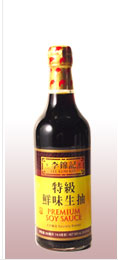
Next on the list is Light Soya Sauce. Made from fermented soya bean, light soya sauce is a good substitute for salt as it is salty with a hint of sweetness (depending on the quantity of sugar and salt used in the fermentation process). There are many brands available and recently, I had the chance to try out Lee Kum Kee's Premium Soy Sauce above and was quite impressed. It is not overly salty and rather light. This is forgiving because if you are using light soya sauce which is very salty in taste, you might spoil your dish with saltiness if you add a tad too much during cooking.
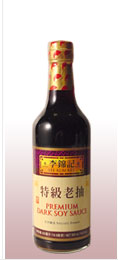
If you have light soya sauce, you must not forsake the Dark Soya Sauce. Dark soya sauce is of course, darker in colour than its light counterpart but that's not all. Generally, the taste is sweeter than salty though just like light soya sauce, the level of sweetness depends on the manufacturer. I currently use the Kadory brand which is a local brand. It is runny just like the light soya sauce unlike some brands which are thick and slightly sticky. Dark soya sauce is sometimes added to colour the dish and sometimes used as a dip. The picture above is for illustration purposes.

Next stop, the Shao Hsing rice wine. A must-have in chinese kitchens, it is used in quite a lot of recipes. Besides being a seasoning ingredient (it adds aroma and sweetness to the dish), it is also used as a marinade. There are many brands available in the market and most of them are called Shao Hsing or Tsao Tsing rice wine. Most likely due to its origin in China.
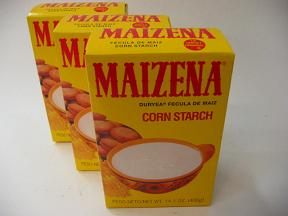
Apart from the above, I also have corn flour or corn starch in my kitchen. It is used in marinades (to seal the meat, I think) as well as to mixed with water to form starch to thicken gravies. When used as corn starch, it can give some dishes eg. vegetables a smooth feel when eaten.
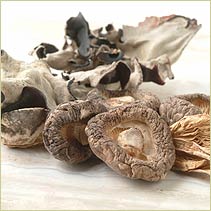
If you have checked out some of my recipes, one of my most used items is dried chinese mushrooms. I understand that these are shiitaki mushrooms. It has a smoky flavour and depending on one's taste buds, can be either heavenly or repulsive. Those grown in Japan are the most expensive and I find them fragrant. The good quality ones have nice "flower" patterns on the top of the mushroom. These dried mushrooms are always pre-soaked with water to soften it. If you know you are going to cook them, it is best to pre-soak them overnight to enable the mushrooms to be fully hydrated. That way, they will be able to absorb whatever gravy you are cooking as well as imparting it's own taste to the dish you are cooking.
Apart from the above, other essentials are too obvious to mention eg. salt, sugar, cooking oil and such. I do have monosodium glutamate as well (Ajinomoto) but I rarely use it. It is a taste enhancer and if I do actually use it, I only take a pinch.
By the way, I don't get paid by any of the companies above by writing this post :)
Technorati Tags :
Chinese Cooking ,
Ingredients ,
SauceLabels: Ingredients


Thursday, November 16, 2006
posted by pablopabla at 10:45 am
 Hot and Sour Szechuan Vegetable Soup
Hot and Sour Szechuan Vegetable Soup
Got szechuan vegetable in your kitchen? Why not cook soup with it? Szechuan vegetable which is preserved with chilli and salt imparts a distinct flavour when cooked in soup. The soup will be spicy hot and salty. When you add a couple of tomatoes into the soup, it's be hot and sour. Definitely appetising especially when eaten with
long bean rice or even
cabbage rice.
Depending on how hot or salty you want your soup to end up, you can actually wash or even soak the preserved szechuan vegetable prior to cooking. I usually just wash the szechuan vegetable rather than soaking as I like the original taste of the preserved vegetable. My mum adds a couple of cloves of garlic for added taste but I don't really fancy that. You can try it if you want.
This recipe is simple and not intimidating for first timers!
This is my recipe for
Hot and Sour Szechuan Vegetable Soup.
Ingredients- 1 piece szechuan vegetable larger than the size of an egg (washed and sliced)
- 3 - 4 large tomatoes (quartered)
- 50 to 100 grammes of minced pork or pork ribs or chicken parts
- 2 soup bowls or 600 ml of water
MethodBring water to boil and add sliced szechuan vegetables and tomatoes. If you are using pork ribs or chicken parts, add them now. Simmer for 1 hour or more till water reduced to approximately 1 soup bowl.
If using minced pork, 3 minutes before intended serving, bring back to boil and add minced pork shaped into small balls.
Serve steaming hot.
How about stir-frying the szechuan vegetable? My recipe for Stir-Fried Pork with Preserved Szechuan Vegetable here.
Technorati Tags :
Soup ,
Recipe ,
Szechuan Vegetable ,
Chinese FoodLabels: Dinner, Soup, Vegetable


Tuesday, November 14, 2006
posted by pablopabla at 4:30 pm
 Cabbage Rice with Lap Cheong
Cabbage Rice with Lap CheongThis is my 3rd recipe for rice cooked in a rice cooker. Prior to this, I have a recipe for
Chicken Rice as well as
Long Bean Rice. This is another one of the vegetable rice recipes which can serve as a meal on its own.
Cabbage Rice with Lap Cheong (Chinese Sausages) is quite mild in flavour but sweet in taste. The sweetness comes from the cabbage. The type of cabbage we usually use is the chinese cabbage, which is white in colour and longish in shape rather than round. Try not to leave the rice uneaten overnight as I believe that the cooked cabbage does not withstand being kept overnight that well.
If you don't have lap cheong, you can even substitute it with ham or even salami! Do experiment. As I have emphasised many times before in my recipes, you can actually experiment with the ingredients once you get the basic idea of how the dishes are cooked. The presentation of the rice in the picture above could be much better but the taste definitely is!
This is my recipe for
Cabbage Rice with Lap Cheong (Chinese Sausages)
Ingredients- 2 cups rice pre-soaked for 30 minutes (measured using the cup that comes with your rice cooker)
- About 400 grammes of chinese cabbage (shredded roughly)
- 400 grammes of belly pork (try to get the 3-layered pork. Remove skin)
- 5 to 8 pieces dried chinese mushrooms (pre-soaked till soft. Remove from water and cut to slivers but retain water for later use)
- 50 grammes of dried prawns / shrimps (pre-soaked for 5 minutes. Remove from water but retain water for later use)
- 3 to 5 lap cheong (remove skin and slice thinly diagonally)
- 5 cloves shallots (sliced thinly)
- 2 tablespoons of cooking oil (preferably palm oil)
- 3 bowls of water
Seasoning- 4 teaspoons salt
- 1/2 teaspoon white pepper powder
- 2 teaspoon light soya sauce
- 2 tablespoon dark soya sauce
- A pinch of msg (optional)
MethodBring water to boil. Add belly pork and let it boil till cooked. Remove pork. Cut into small pieces.
Heat oil in wok and fry shallots till golden brown. Remove fried shallots.
With remaining oil in wok, fry the cooked belly pork till beginning to brown. Remove pork. With remaining oil, fry the dried prawns and chinese mushrooms for 1 minute till fragrant. Add cabbage and put back the pork into the wok and continue to stir fry for 1 more minute. Add seasoning and a little bit of water (used to soak mushrooms / dried prawns) to keep it moist.
Add pre-soaked rice into the ingredients and stir well for 1 minute.
Transfer the ingredients into rice cooker and add water till it covers rice completely just like how you usually cook rice. Turn on the rice cooker. Check occasionally for water to dry out from the upper layer of the rice. Once that happens, place lap cheong on top of the rice, cover lid and wait for rice to cook completely.
Sprinkle fried shallots over rice before serving.
Technorati Tags :
Recipe ,
Rice ,
Recipe ,
Chinese FoodLabels: Dinner, Rice, Vegetable


Friday, November 10, 2006
posted by pablopabla at 9:46 am
 Fish Ball Bee Hoon Soup
Fish Ball Bee Hoon Soup
Once in a while, we will cook Fish Ball Bee Hoon Soup for lunch on a weekend. Bee Hoon is also known as Rice Vermicelli. The clear soup is refreshing especially on a hot day. We usually use Ikan Bilis stock for the soup as it makes the soup tastier.
I would advise that you buy the Fish Balls from the wet market and have it cooked the same day to enjoy its freshness. If you are unable to cook them on the same day, do keep them in the fridge and cook them the next day. I don't think preservatives are added to these fish balls and so, they don't last long.
This is my recipe for
Fish Ball Bee Hoon Soup. Serves 4 people.
Ingredients- 1/2 packet of bee hoon (approximately 150 grammes) (pre-soaked in water for 30 minutes to soften)
- 15 to 20 fish balls
- 100 grammes of pork tenderloin (sliced thinly) (optional)
- 200 grammes of choy sum (chinese mustard leaves) (washed and cut into 6 cm lengths)
- 5 to 8 shallots (sliced thinly)
- 100 grammes of ikan bilis (dried anchovies)
- a pinch of salted chinese vegetables (tung chai)
- 3 tablespoons of palm oil
- 1.25 litres or 5 soup bowls of water
Marinade (for pork tenderloin slices)- 2 teaspoons of light soya sauce
- a couple of dashes of white pepper powder
- 1 teaspoon of corn flour
Seasoning- 2 tablespoons of light soya sauce
- Salt to taste
- 1/2 teaspoon of MSG (optional)
MethodMarinade pork tenderloin slices for 30 minutes. Meanwhile, boil ikan bilis in water for at least 45 minutes. Remove ikan bilis when done.
Fry shallots in oil under medium heat till golden brown. Remove fried shallots from oil and set aside.
With remaining oil in wok / pot, stir-fry the pork tenderloin slices for 30 seconds. Add ikan bilis stock above and bring to boil.
Add pre-soaked bee hoon into boiling stock followed by choy sum and fish balls and let the ingredients cook for at least 2 minutes in boiling condition. The fish balls will float to surface when cooked. Add seasoning to taste.
Separate into individual bowls and sprinkle fried shallots and chinese salted vegetables prior to serving.
My other Bee Hoon Recipes :
Sarawak LaksaBee Hoon with Chicken Frankfurters and Chinese MushroomsFried Bee Hoon with Stewed Pork RibsTechnorati Tags :
Fish Ball ,
Bee Hoon ,
Soup ,
RecipeLabels: Beehoon, Lunch, Soup


Wednesday, November 08, 2006
posted by pablopabla at 2:52 pm
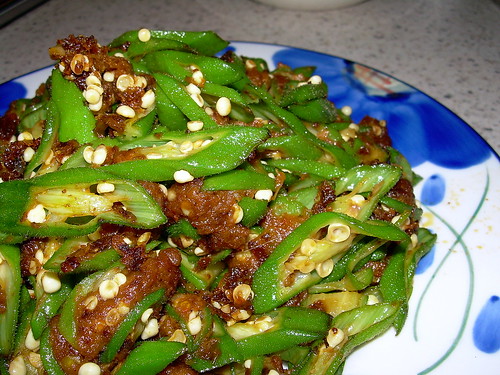 Sambal Belacan Ladies Finger
Sambal Belacan Ladies Finger
Ladies finger, also known as Okra, is a fibrous pod full of round white seeds.
Packed with vitamins and minerals, it is often used in Asian cuisine especially in India. Back home in Malaysia, it is commonly added to Assam Fish or Curry Fish. It is also cooked as a dish of its own and I usually stir-fry it with belacan sambal.
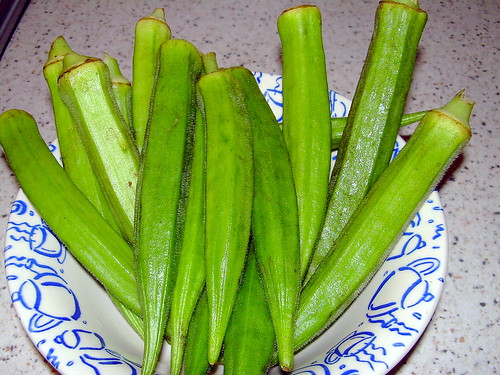 Ladies Finger or Okra
Ladies Finger or Okra
When choosing ladies finger, choose the younger pods which are usually lighter green in colour and smaller in size. Usually, the younger pods will have softer fur-like skin. These younger pods are more tender in texture and less fibrous.
And again, just like
Kangkong Belacan, you should cook this dish using really high heat as you want to cook it in minimum time to preserve its juice.
This is my recipe for
Sambal Belacan Ladies FingerIngredients- Approximately 15 pieces of ladies finger (washed and sliced diagonally. Discard top / head)
- A pinch of sugar
- 50 ml warm water
- 2 tablespoons cooking oil (preferably palm oil)
Sambal belacan mix (pound / blended together)- 50 grammes dried prawns / shrimps (pre-soaked for 10 minutes to soften)
- 20 grammes of belacan (buy from stores)
- 5 to 8 cloves garlic
- 5 to 8 cloves shallots
- 3 to 5 red chillis (remove seeds if you want the sambal to be less hot)
MethodHeat oil on wok at medium heat. Stir-fry the sambal belacan mix for about 2 minutes.
Increase heat to high and add ladies finger and sugar. Stir well for about 2 minutes or till the ladies finger is to your desired softness. Add a little water at a time if sambal belacan mix beginning to burn. As the sambal belacan mix contains dried prawns and belacan which are salty in itself, it may not be necessary to add salt.
Technorati Tags :
Ladies Finger ,
Okra ,
Recipe ,
VegetableLabels: Dinner, Lunch, Vegetable


Tuesday, November 07, 2006
posted by pablopabla at 9:42 am
 Simplified Kung Po Chicken
Simplified Kung Po Chicken
Kung Po Chicken is a common dish found in most, if not all, chinese restaurants. This dish is basically diced chicken stir-fried with onions, dried chillies, cashew nuts and capsicum. Some even add water chestnuts to the dish. The aroma from the chicken which was marinated with chinese cooking wine blends well with the spiciness of the dried chillis. Meanwhile, the tender bits of chicken meat is contrasted with the crunchiness of the capsicum and onions. The cashew nuts lend a natural sweetness to the dish.
 Dried Chillis
Dried ChillisAnyway, I am not that good expressing how a dish tastes like, so I shall keep it short and simple. This dish is best eaten with plain white rice so that you can savour the full taste and aroma of the dish. Some have substituted the chicken with cuttlefish, which is quite a good alternative.
 Simple ingredients, delicious taste
Simple ingredients, delicious tasteIn my recipe, I have simplified the dish to my own liking. I have omitted the use of the capsicum and perhaps, the sauce is a bit different from the original recipes by professional cooks. However, I am still confident that you will like this dish if you try it out.
This is my recipe for
Simplified Kung Po Chicken.
Ingredients- 300 grammes chicken breast (cut into cubes / bite sizes)
- 2 medium sized onions (quartered)
- 10 to 15 pieces of dried chilli (washed and pre-soaked for 15 minutes prior to cooking)
- 20 to 30 pieces of cashew nuts
- 1 1/2 cups of cooking oil (preferably palm oil)
- 1/2 cup (70 to 100 ml) warm water
Marinade for chicken- 2 tablespoons of chinese cooking wine
- 1 1/2 tablespoons of light soya sauce
- 1/2 teaspoon of salt
- 1/2 teaspoon of white pepper powder
- 1 teaspoon of sesame oil
- 1 1/2 tablespoons of corn flour
Seasoning- 1 1/2 tablespoons of dark soya sauce
- 1 1/2 teaspoons of sugar
- A pinch of salt
- 1 teaspoon of chinese cooking wine
MethodMarinade chicken cubes for at least 1 hour.
Heat oil in wok on high. Fry chicken cubes till golden brown. Remove from oil and place aside.
Remove cooking oil from wok leaving about 1 tablespoon in the wok. Add onions and dried chillis and stir-fry for 30 seconds to bring out the aroma.
(If you wish to add capsicums which are cut into cube sizes, add them at this stage) Add pre-fried chicken cubes and cashew nuts and stir well for a minute.
Add seasoning and 1/2 cup water and close lid. Stir occasionally till water / gravy reduced by half.
Serve hot with plain white rice.
Technorati Tags :
Chicken ,
Chinese Food ,
Recipe ,
Kung Po ChickenLabels: Chicken, Dinner, Lunch


Monday, November 06, 2006
posted by pablopabla at 2:17 pm
 Stir-Fried Pea-Sprouts with Garlic
Stir-Fried Pea-Sprouts with GarlicPea-Sprouts are also known as "Tou Miau" in Mandarin. Rich in vitamins and minerals, it is considered one of the easiest vegetable to stir-fry. Popular in many Chinese restaurants, the prices of these pea-sprouts have risen over the years due to its high demand.
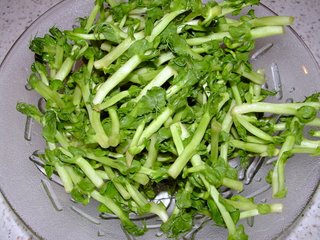 Fresh Pea-Sprouts
Fresh Pea-SproutsWhen cooking this dish, it is important to have the wok heated at high as you need to cook the pea-sprouts in minimum time to preserve its nutrients and to ensure that the juices are retained in the sprouts. Else you will have a flooded dish!
This is my recipe for
Stir-Fried Pea Sprouts with GarlicIngredients- 300 grammes pea-sprouts (rinse with water to remove dirt prior to cooking)
- 5 to 8 cloves garlic (chopped finely)
- 2 tablespoons cooking oil (preferably palm oil)
Seasoning- 1 1/2 teaspoons oyster sauce
- Salt to taste
- A dash of white pepper powder
MethodHeat wok till wok starts to smoke.
Add oil followed by garlic. Give the garlic a few quick stir and add the pea-sprouts.
Continue to stir-fry briskly whilst adding seasoning. Cook until pea-sprouts begin to wilt to your desired softness or reduced by 1/2 in bulk. Add one or two tablespoons of warm water if you prefer some gravy.
Technorati Tags :
Pea Sprouts ,
Vegetable ,
Chinese Food Labels: Dinner, Vegetable


Friday, November 03, 2006
posted by pablopabla at 1:58 pm
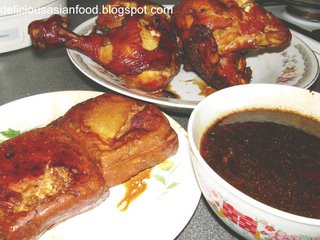 Clockwise from top : Stewed Chicken in Dark Soya Sauce,
Clockwise from top : Stewed Chicken in Dark Soya Sauce,
the gravy and Stewed Beancurd in Dark Soya SauceThis recipe is EASY. You should try it, if you have not. It is different from
Tau Yu Bak (Stewed Pork in dark soya sauce) in taste but can be similar to Stewed Duck in Dark Soya Sauce save for some difference in spices used.
I used to cook this dish quite often during my university days in England and my British housemates loved it when eaten with steaming hot rice! If you make an extra effort and fry the rice ala
Egg Fried Rice, you will have a truly satisfying meal. The beancurd is a complimentary item which I add to the dish. You can also add hard boiled eggs (shell removed, of course) into the dish during the simmering stage.
This is my recipe for Stewed Chicken in Dark Soya Sauce
Ingredients- 2 chicken legs (whole)
- 3 tablespoons sugar
- 2 whole bulbs garlic (remove skin)
- Approximately 15 - 20 white peppercorns
- Warm water
- 1 piece star-anise (optional)
- 2 pieces hard-type beancurd (optional)
- 2 large hard-boiled eggs (optional)
Seasoning- 2 to 3 tablespoons dark soya sauce
- 1/2 teaspoon of salt
MethodAdd sugar into a wok / saucepan which has been heated up. Let the sugar caramelise (turn liquid and brown).
Once sugar fully caramelised, add chicken legs and let it "sear" for 1 minute on each side. Add water to cover the chicken by 1 to 2 cm. Add the rest of the ingredients and seasoning. Once water begins to boil, reduce to medium low heat, cover lid and let it simmer for 30 minutes to an hour.
To serve, separate gravy from the rest of the ingredients. Chop the chicken to desired size, cut beancurd into quarters and half the eggs.
Technorati Tags :
Chicken ,
Recipe ,
FoodLabels: Chicken, Dinner


Wednesday, November 01, 2006
posted by pablopabla at 3:10 pm
 Stir-Fried Kai-Lan Stems with Pork and Mushrooms
Stir-Fried Kai-Lan Stems with Pork and Mushrooms"Oh no! Not another recipe with mushrooms!" Ha! Ha! Well, can't help it when I have a lot of mushrooms at home. Chinese dried mushrooms to be precise. But anyway, the mushrooms here are the supporting act. The main actor is the Kai Lan stems.
According to the
Wikipedia,
Kai-lan, also known as
Chinese broccoli or
Chinese kale, is a slightly bitter leaf vegetable featuring thick, flat, glossy blue-green leaves with thick stems and a small number of tiny, almost vestigial flower heads similar to those of broccoli. As a group of
Brassica oleracea kai-lan is of the same species of plant as
broccoli and kale. Its flavor is very similar to that of broccoli, though not identical, being a bit sweeter.
In this recipe, I use the kai-lan stems. These are usually imported and sold in supermarkets. Unfortunately, I forgot to take a picture of it prior to cooking. What you get is a stem roughly 15 to 20cm long and with very little or no leaf. It tastes much sweeter than the leaves in "normal" the normal kai-lan vegetable. I am told that this variety of kai-lan is grown specifically for its crunchy and sweet tasting stem.
The ideal way to cook this stem is to stir-fry it with medium or large sized prawns which have been deveined and cut "butterfly style". If you are rich enough, you can consider adding scallops! As I don't have any prawns at home when I decided to cook this dish and I am not rich enough to consider scallops, I used pork and mushrooms as the supporting cast.
This is my recipe for
Stir-Fried Kai-Lan Stems with Pork and MushroomsIngredients- 3 to 5 kai-lan stems (lightly scrape the layer of skin from the stem and slice diagonally)
- 50 grammes of pork tenderloin (sliced thinly)
- 2 to 3 pre-soaked chinese mushrooms
- 4 cloves garlic (chopped finely)
- 1 tablespoon of palm oil
- 1/2 cup warm water
- 2 teaspoons cornflour mixed with 1/2 cup water to make corn starch
Marinade for pork tenderloin- 2 teaspoon light soya sauce
- a pinch of white pepper powder
- 1 teaspoon corn flour
Seasoning- 1 tablespoon oyster sauce
- Salt to taste
- 2 teaspoons chinese cooking wine (optional)
- A dash of white pepper powder
MethodMarinade pork tenderloin for 30 minutes.
Heat oil in wok and fry garlic till beginning to brown. Remove garlic from oil.
Add pork tenderloin and chinese mushrooms into remaining oil in wok and stir fry for 1 minute. Add kai-lan stems and pre-fried garlic and stir-fry briskly for 1 minute. Add one or two teaspoons of warm water to prevent burning.
Add seasoning
(except chinese cooking wine) followed by remainder of water and cover lid. Allow to cook for 1 to 2 minutes whilst checking occasionally for drying out of gravy.
Once the stems have more or less turned to a darker colour, add chinese cooking wine and stir well. If the sauce is too thin to your liking, add a little bit of corn starch to thicken it.
Serve hot with white rice.
Technorati Tags :
Kai Lan ,
Vegetable ,
Chinese Food ,
RecipeLabels: Dinner, Lunch, Vegetable




























